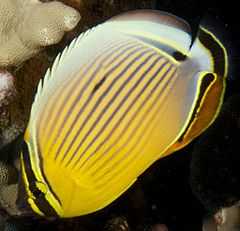Oval butterflyfish
- Not to be confused with the Red-tailed Butterflyfish (C. collare) and Chaetodon lunula (Raccoon Butterflyfish).
| Red-finned Butterflyfish | |
|---|---|
 | |
| Conservation status | |
| Scientific classification | |
| Kingdom: | Animalia |
| Phylum: | Chordata |
| Class: | Actinopterygii |
| Order: | Perciformes |
| Family: | Chaetodontidae |
| Genus: | Chaetodon (but see text) |
| Subgenus: | Corallochaetodon |
| Species: | C. lunulatus |
| Binomial name | |
| Chaetodon lunulatus Quoy & Gaimard, 1825 | |
The Oval Butterflyfish, Red-finned Butterflyfish or redfin butterflyfish (Chaetodon lunulatus) is a species of butterflyfish (family Chaetodontidae). It is found in the Pacific Ocean from Eastern Indonesia to the Hawaiian islands. This is one species of a closely related group which includes the Blacktail butterflyfish which is found in the Red Sea and Gulf of Aden and the Melon butterflyfish which is found in the Indian Ocean.[1]
The Black-tailed Butterflyfish (C. austriacus) and the Melon Butterflyfish (C. trifasciatus) and the Oval Butterflyfish (C. lunulatus) are similar in coloration. The former has black caudal and anal fins, while the latter is an Indian Ocean species and has a more conspicuous back patch below the dorsal fin and a mainly yellow anal fin.[2]
Together with the Black-tailed and Melon butterflyfishes and probably also the somewhat aberrant Arabian Butterflyfish (C. melapterus) it makes up the subgenus Corallochaetodon. They are probably quite close to the subgenus called "Citharoedus" (that name is a junior homonym of a mollusc genus), which contains for example the Scrawled Butterflyfish (C. meyeri). Like that group, they might be separated in Megaprotodon if the genus Chaetodon is split up.[3]
The Oval Butterflyfish is found at depths between 2 and 20 m in coral-rich lagoons and semi-protected seaward reefs. Small juveniles are secretive and hide in corals. Growing to a maximum of 15cm long, the monogamous adults swim in pairs and may be territorial and aggressive to other Chaetodon. Oval Butterflyfish feed exclusively on coral polyps. They are oviparous.[1]
Footnotes
References
- Fessler, Jennifer L. & Westneat, Mark W. (2007): Molecular phylogenetics of the butterflyfishes (Chaetodontidae): Taxonomy and biogeography of a global coral reef fish family. Mol. Phylogenet. Evol. 45(1): 50–68. doi:10.1016/j.ympev.2007.05.018 (HTML abstract)
- FishBase [2008]: Chaetodon lunulatus. Retrieved 2008-SEP-01.
- Hsu, Kui-Ching; Chen, Jeng-Ping & Shao, Kwang-Tsao (2007): Molecular phylogeny of Chaetodon (Teleostei: Chaetodontidae) in the Indo-West Pacific: evolution in geminate species pairs and species groups. Raffles Bulletin of Zoology Supplement 14: 77-86. PDF fulltext
- Lieske, E. & Myers, R.F. (2004): Coral reef guide – Red Sea. HarperCollins, London. ISBN 0-00-715986-2
